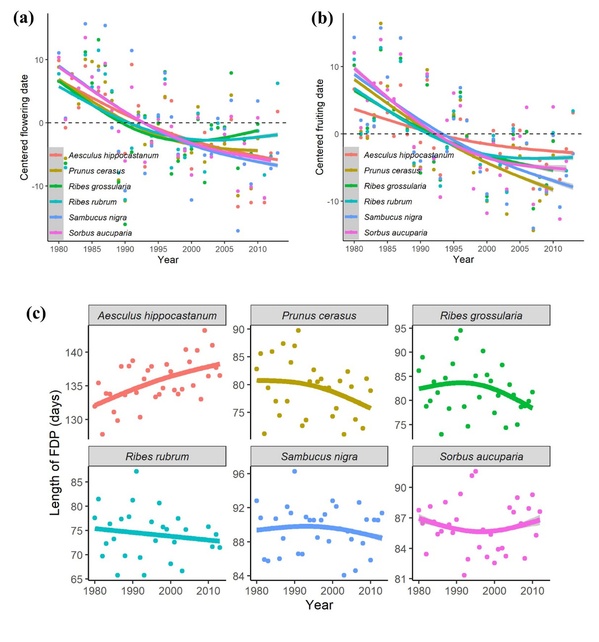Contrasting reproductive phenological strategies among temperate woody species discovered
On July 28, the research team led by Prof. HUANG Jianguo at the Zhejiang University College of Life Sciences published an article entitled “Climate warming leads to advanced fruit development period of temperate woody species but divergent changes in its length” in the journal Global Change Biology.
Climate warming has significantly altered the phenology of plants in recent decades. However, in contrast to the widely reported warming-induced extension of vegetative growing season, the response of fruit development period (FDP) from flowering to fruiting remains largely unexplored, particularly for woody plants. Analyzing >560,000 in situ observations of both flowering and fruiting dates for six temperate woody species across 2958 European phenological observations sites during 1980 – 2013, Huang Jianguo’s team found that in all species both flowering and fruiting phenology, i.e., the FDP, advanced with climate warming. However, the advancing rates of the two events were not necessarily equal for any given species, resulting in divergent changes in the length of FDP among species with climate warming. During 1980 – 2013, not only the temperature during FDP but also the forcing requirement for fruit development increased, both affecting the length of FDP. The shortened FDP was mainly due to elevated temperature, thus accelerating the accumulation of forcing, whereas the prolonged FDP was primarily caused by the substantial increase of the forcing requirement of fruiting, which could be fulfilled only in a longer time and thus slowed down the advance of fruiting.

Flowering date (a), fruiting date (b), and the length of fruit development period (FDP) (c) in six woody species in Europe during 1980–2013.
This study by HUANG Jianguo’s team provides large-scale empirical evidence of warming-induced advances of FDP but divergent changes in its length in temperate woody species. Their findings demonstrate the contrasting reproductive phenological strategies among temperate woody species under the pressure of warming climate, contrary to the lengthening of vegetative growing season, which is by and largely similar with different woody species.